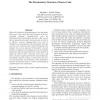Free Online Productivity Tools
i2Speak
i2Symbol
i2OCR
iTex2Img
iWeb2Print
iWeb2Shot
i2Type
iPdf2Split
iPdf2Merge
i2Bopomofo
i2Arabic
i2Style
i2Image
i2PDF
iLatex2Rtf
Sci2ools
INFSOF
2002
2002
The documentary structure of source code
Many tools designed to help programmers view and manipulate source code exploit the formal structure of the programming language. Language-based tools use information derived via linguistic analysis to offer services that are impractical for purely text-based tools. In order to be effective, however, language-based tools must be designed to account properly for the documentary structure of source code: a structure that is largely orthogonal to the linguistic but no less important. Documentary structure includes, in addition to the language text, all extra-lingual information added by programmers for the sole purpose of aiding the human reader: comments, white space, and choice of names. Largely ignored in the research literature, documentary structure occupies a central role in the practice of programming. An examination of the documentary structure of programs leads to a better understanding of requirements for tool architectures.
| Added | 22 Dec 2010 |
| Updated | 22 Dec 2010 |
| Type | Journal |
| Year | 2002 |
| Where | INFSOF |
| Authors | Michael L. Van de Vanter |
Comments (0)

